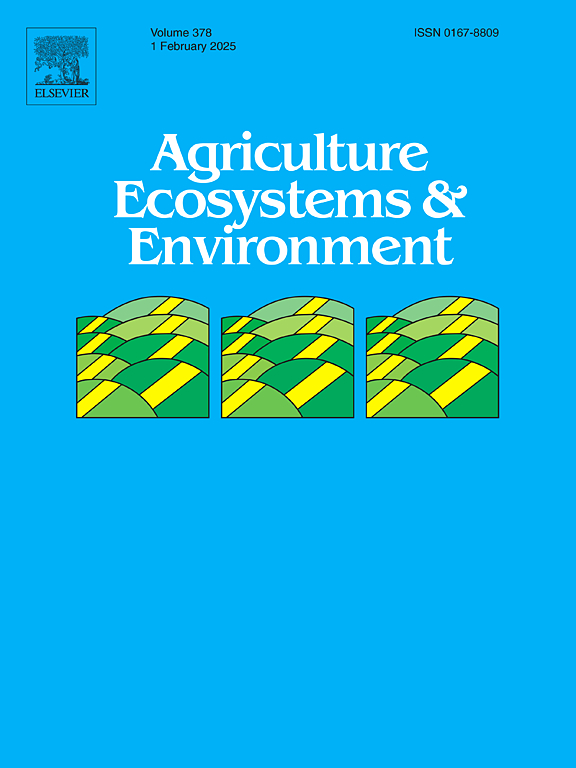Biochar mitigates greenhouse gas emissions from bulk soil in wheat-corn rotation system by inhibiting biochemical decomposition
IF 6
1区 农林科学
Q1 AGRICULTURE, MULTIDISCIPLINARY
引用次数: 0
Abstract
Excessive greenhouse gas (GHG) emissions contribute to global climate deterioration and disrupt ecosystems. Although biochar and straw can enhance soil C sequestration, their effects on soil GHG emissions and the underlying mechanisms are unclear. Therefore, exploring the differences in physicochemical properties of biochar and straw and their mechanisms affecting soil GHG emissions from different perspectives is crucial for optimizing crop residue utilization strategies to balance soil C sequestration and soil GHG emissions. Herein, soil GHG emissions (CO2, CH4, and N2O emissions) from bulk soils of wheat-corn rotational systems under different treatments of biochar and straw were continuously monitored for 7 years. The differences in properties between biochar and straw and their interactions with soil enzymes were analyzed via molecular simulation computational techniques to investigate the mechanisms by which biochar and straw affect soil GHG emissions. The results indicated that biochar reduced CO2eq emission by 14028.1 kg ha−1 (equivalent to 31.5 % of emissions from the control) compared to the control in a 7-year wheat-corn rotation system through the reduced interaction with soil active enzymes and the improvement of soil physicochemical properties. The active surface properties facilitated the interactions of straw with soil active enzymes and its biochemical decomposition, thus increasing CO2eq emissions by 19242.0 kg ha−1 compared the control. These findings enhance the understanding of the mechanisms by which biochar and straw affect soil GHG emissions and may improve the development of sustainable agricultural practices that balance soil C sequestration and GHG emission reductions.
过多的温室气体(GHG)排放导致全球气候恶化并破坏生态系统。虽然生物炭和秸秆可以增强土壤碳固存,但它们对土壤温室气体排放的影响及其潜在机制尚不清楚。因此,从不同角度探讨生物炭和秸秆的理化性质差异及其对土壤温室气体排放的影响机制,对于优化作物秸秆利用策略以平衡土壤固碳和土壤温室气体排放具有重要意义。以小麦-玉米轮作系统为研究对象,连续监测不同生物炭和秸秆处理下大块土壤的温室气体(CO2、CH4和N2O)排放。利用分子模拟计算技术分析了生物炭和秸秆的特性差异及其与土壤酶的相互作用,探讨了生物炭和秸秆对土壤温室气体排放的影响机制。结果表明,在7年小麦-玉米轮作系统中,生物炭通过减少与土壤活性酶的相互作用和改善土壤理化性质,使co2当量排放量比对照减少了14028.1 kg ha−1(相当于对照排放量的31.5 %)。秸秆的活性表面特性促进了秸秆与土壤活性酶的相互作用及其生化分解,从而使co2当量排放量比对照增加19242.0 kg ha−1。这些发现加强了对生物炭和秸秆影响土壤温室气体排放机制的理解,并可能促进可持续农业实践的发展,以平衡土壤碳固存和温室气体减排。
本文章由计算机程序翻译,如有差异,请以英文原文为准。
求助全文
约1分钟内获得全文
求助全文
来源期刊

Agriculture, Ecosystems & Environment
环境科学-环境科学
CiteScore
11.70
自引率
9.10%
发文量
392
审稿时长
26 days
期刊介绍:
Agriculture, Ecosystems and Environment publishes scientific articles dealing with the interface between agroecosystems and the natural environment, specifically how agriculture influences the environment and how changes in that environment impact agroecosystems. Preference is given to papers from experimental and observational research at the field, system or landscape level, from studies that enhance our understanding of processes using data-based biophysical modelling, and papers that bridge scientific disciplines and integrate knowledge. All papers should be placed in an international or wide comparative context.
 求助内容:
求助内容: 应助结果提醒方式:
应助结果提醒方式:


